Could your home office use a writing space makeover?
If it’s been a while, I suggest you think about it. Especially with the new year upon us, it’s a great time to re-evaluate where you write and how you might be able to improve it.
I recently made some recent changes to my writing space. After about 15 years of working in the same place with the same desk and the same everything else, I came up against some issues that made it clear it was time for change.
I’m amazed at how many benefits I’ve experienced as a result of the upgrade. You, too, may be missing out on some simple things that could help you increase your productivity, focus, and creativity.
It’s that impactful!
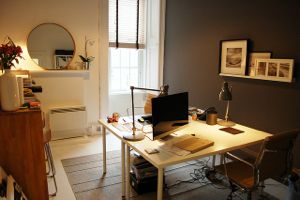 Writing Space Makeover: Sometimes We Outgrow the Spaces We’ve Built
Writing Space Makeover: Sometimes We Outgrow the Spaces We’ve Built
When I first moved to full-time freelance writing about 17 years ago, I imagined it would be best to put my “office” in an extra bedroom or somewhere away from the rest of the house.
I tried it, but it didn’t work.
Isolating myself hurt my productivity. I felt shut away, which hurt my focus. Plus, I was too far away from things like hot water for coffee and tea, cold water, snacks, a glance out a nice big window, etc.
I wanted to be in the main room (the living room). But that presented what seemed to me to be a problem: a writing desk there wouldn’t be very attractive.
To solve the issue, I got a writing armoire—a nice tall piece of furniture in which I could put my computer and keyboard and all my reference books and office supplies, but that had two tall doors I could close every night. Closing those doors felt like leaving the office behind. Plus it created a piece of furniture that didn’t look like an office.
Here are a couple pictures of the armoire, both opened and closed. You can see how it hides everything away.
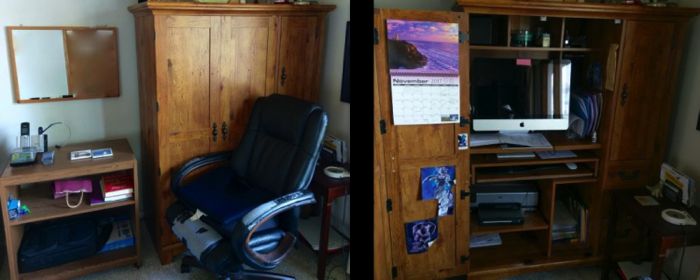
The piece worked wonderfully for me for years and years. I never thought twice about doing anything else, until this year.
 You Deserve a Writing Space that Works for You
You Deserve a Writing Space that Works for You
A couple years ago, I had an old back injury flare up. In addition to getting a Teeter inverter (read more about that here), I started standing up more to write.
I used an old file box and a clean plastic trash can turned upside down on which to balance my keyboard and mouse. For a long time that worked just fine.
But this year, I started to get frustrated. I realized that hours of standing had its own hazards (read more about those here). Through my research and experience, I determined that the ideal situation was a combination of both sitting and standing.
But that meant moving my file box and trash can multiple times a day—inconvenient to say the least. Plus, I noticed that for the first time, I started to really crave more desk space. My little armoire was starting to feel cramped.
I “got by” for many months. But this was one of those situations where I had to say to myself: “You’ve been a full-time professional writer for 20 years. You deserve this.”
Researching a New Writing Space
I dove into researching a new desk for my writing space. It took me a long time to find the right one. (A long time.)
Part of the problem is that most office stores have only limited inventory on hand. That meant I had to carefully measure my writing space, compare those measurements to those of the desks and hutches I was finding online, then try to visualize the desk in that place to “see” if it would work.
Even when I found one I felt good about, I hesitated. I knew that once I got it shipped and put together, it would be very hard to return if I didn’t like it. A coupon and some support from a friend helped me take the plunge. I ordered the new desk, and I’m so glad I did. Here’s why.
Surprising Benefits of a Writing Space Makeover
It took time to get the desk and hutch shipped in. Though I could have put the desk together myself, the hutch required some assistance. It was about a 5-hour project from beginning to end. Once it was completed, I could tell immediately that it was a huge improvement.
Check it out:
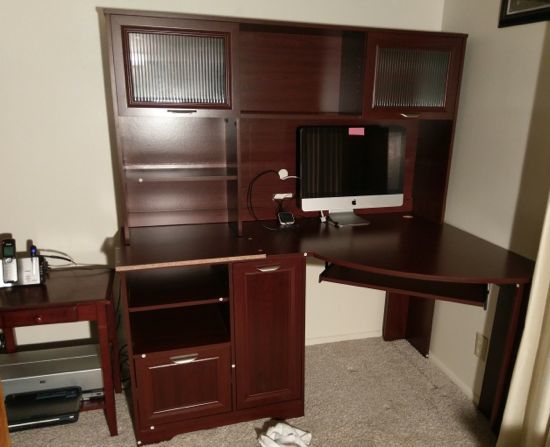
The first day I worked at the desk, I felt like a giddy kid with a new toy. Suddenly I had room for my schedule and my printed articles awaiting editing, along with my tea, water, and phone, which I’d tucked away toward the back. I felt like I had just received a promotion to a new corner office.
But the next thing I felt surprised the heck out of me, and here’s what I wanted to share: updating my writing space improved my focus and productivity.
I had blazed through my projects with hardly a break. (Usually I need to practice the “chunking” technique I talk about in Overwhelmed Writer Rescue.) I chalked it up to the newness of everything, but I’ve had the desk for several weeks now, and the effect is still the same. I’m working faster and easier with more focus than I was before.
A New Writing Space Can Improve Your Working Mindset
This was the biggest surprise for me. I expected that I would have more room and that I’d be more comfortable sitting and standing at the desk, but I never even thought that the change could improve my mental state while working. I mean, I have been doing this for awhile!
Still, I felt more professional, even more “at work” than I had for over a decade.
I think there are several reasons for this. One, the desk is a “corner desk,” so the working space actually faces the corner. It seems to promote a more focused state.
 As expected, the extra space helps me feel like I can move more easily from task to task. But it also gives me a sense of calm that I didn’t expect. Clutter can cause stress and reduce focus, but I’m a neat person. I never thought that clutter was an issue for me.
As expected, the extra space helps me feel like I can move more easily from task to task. But it also gives me a sense of calm that I didn’t expect. Clutter can cause stress and reduce focus, but I’m a neat person. I never thought that clutter was an issue for me.
But looking back at my armoire compared to my desk, I can clearly see that there was a lot more “stuff” in my field of vision in the armoire than there is in my desk. My extra papers are now tucked away in lower shelves that I can’t see, instead of being right in front of me like they were before.
The new hutch also allows me to have some keepsake items on some of the visible shelves that are more decorative (as opposed to just useful), creating a more personal environment. (I added these in after the picture above was taken.)
I was so surprised at all these benefits that I decided to do some research. Is this common, that just changing up your working space can have such an affect on your output?
 Take a Second Look at Your Writing Space
Take a Second Look at Your Writing Space
Turns out that my experience wasn’t unique. Changing up your office space—particularly with some improvements in mind—can help you get more done in less time and feel better doing it.
Most of us know that clutter isn’t a good thing. But my experience showed me that sometimes we aren’t “awake” to our own clutter. We imagine clutter to be one way—excess papers tossed about in an unorganized fashion, for instance. But I discovered that you can have organized clutter, too. You can improve your work by creating an environment that is “friendly” to your eyes.
Scientists have found that the more “stuff” there is around us, the more the brain responds to it, so that it feels like we’re dealing with way more than we are.
Family photos or pictures of other things that you like, on the other hand, can create a sense of calm as you work. Studies have found that photos of nature, in particular, can reduce stress.
Where is Your Writing Space?
Where your writing space is can also make a big difference in your productivity. Do you have natural light nearby? My new desk is in the same corner as my armoire was, but because it faces at an angle, I’m more likely to look out the nearby window now and then to give my eyes a break—a good way to help reduce risk of computer vision syndrome (read more about that here).
The additional space helps me to feel more physically comfortable while I’m working, and makes sitting and standing alternately much easier to accomplish—and that creates benefits for my overall health. (Read about how to create your best, pain-free writing space here.)
I could go on and on, but I’m hoping you’re getting the message—your writing space really does matter. I didn’t realize just how much until I made this change.
With all this in mind, I encourage you to take a second look at where you’re getting your work done. Even if you think it’s just fine for now, there may be improvements you could make that would increase your writing output.
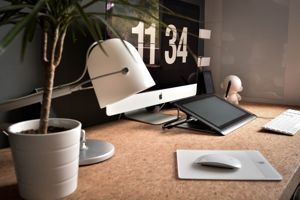 5 Ways to Update Your Writing Space for Increased Focus and Productivity
5 Ways to Update Your Writing Space for Increased Focus and Productivity
1. Put it away.
If you have stacks of papers or open files somewhere on your desk, see if there is a way you can tuck them out of sight while you’re working. Invest in some file boxes and tuck the papers underneath your desk while you’re working.
If you have no other alternatives, consider putting up some photos in front of the stacks so that your eye sees them instead of the papers.
One thing I love about my new desk is that it has a cherry color, which inspires me to make sure everything is off the desk at the end of the day. It also has some nice storage areas in which I can stash those papers I still need to attend to. Find ways that you can clear your work area of anything that can distract you.
 2. Make it friendly for your eyes.
2. Make it friendly for your eyes.
What have you got to look at when you’re not looking at the screen?
We all pause to look elsewhere now and then, especially when we’re thinking of the next sentence to write. Do you have a window through which you can gaze? Some comforting family photos? Some nature photos that relax and inspire you? How might you update those photos to help you get into the zone of writing?
You may also want to consider updating the pictures you have hanging on the wall around you. Changing these up can help energize or calm you, depending on what you use. Colors like green and blue and pictures of nature are calming, whereas colors like orange and yellow are energizing and may help boost your mood.
Finally, look at some of the things you have to have on your desk but that aren’t necessarily all that pretty to look at. Might you put your pens in a picturesque mug, for example? Invest in a novelty clock that is more fun to check? If you have a mouse pad, is it something that improves your day, or is it a plain black or gray color that does nothing for your creativity?
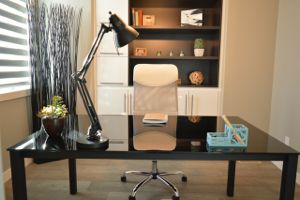 3. Create more comfort.
3. Create more comfort.
One of the things I did after I had worked at my new desk for a while was to get a new office chair. I had used my old one for so many years that the leather covering was flaking off on the arms and on the seat, leaving little flecks behind on the floor each week!
I liked that chair, but after I got the new desk I realized how old it was. (You know how it is—you update one thing and suddenly you see everything else that needs to be updated!) I’ve since gotten a new chair, which has made a big difference.
Consider too whether you may need to create some sort of conversion so you can go from sitting to standing. Even if you write for only an hour or two each day, you probably sit a lot at other times, so it may be good for you to have the option to stand.
You don’t have to buy an expensive standing desk or even a sit-stand desk converter. But it would be good for your long-term health to consider your options. Read more here on finding your best standing desk.
When thinking of comfort, don’t forget things like water and coffee and tea. I have a warming plate I use for my tea (since I don’t drink it fast), and some new coasters for my water that look great on the desk. These little touches can make the whole area feel a bit more special.
 4. Improve your air quality.
4. Improve your air quality.
According to a 2015 study, people who worked in “green” offices with below-average levels of indoor pollutants and carbon dioxide had significantly higher cognitive functioning scores than those working in regular offices.
The Environmental Protection Agency states that indoor air pollution is generally worse than outdoor, so do what you can to improve the air quality around your writing space.
Some good tips include opening a window now and then (even in the cooler weather, just to get the air moving), investing in some houseplants (studies show that some plants can help improve indoor air), and vacuuming and dusting regularly. Plants that have performed well in removing things like ozone, volatile organic compounds, and other toxins from the air include the bromeliad plant, the dracaena, and spider plants.
Avoid synthetic air fresheners as they only add more chemicals to the air. Try simmering some spices on the stove, run an aromatherapy diffuser, or apply some of your favorite essential oil to a cotton ball and place nearby.
 Writing Space Makeover Tip 5. Make sure you have something green.
Writing Space Makeover Tip 5. Make sure you have something green.
In addition to a window, some houseplants can make a big difference to your writing space. Not only do they help to clean the air (as mentioned in #4), they can also improve your productivity simply by being there.
Researchers reported in 2014 that when real plants were added to office areas, workers performed better—and they were 15 percent more productive than workers in offices without plants. “[O]ffice workers’ quality of life can be enriched by office landscaping that involves the use of plants that have no formal work-related function,” the scientists wrote.
“Whatever the environment is generally speaking, it’s a better environment if it’s enriched and plants are a very cost-effective way of enriching your space,” Craig Knight of the University of Exeter told Reuters Health.
You can use one of the plants mentioned above that helps to remove toxins from the air, or you can simply get something small and pretty that makes you happy. You may be surprised at how much it brightens you’re writing time.
Have you upgraded your home office recently?
Sources
McMains S, Kastner S, “Interactions of top-down and bottom-up mechanisms in human visual cortex,” J Neurosci., January 12, 2011; 31(2):587-97, https://www.ncbi.nlm.nih.gov/pubmed/21228167.
Magdalena M. H. E. van den Berg, et al., “Autonomic Nervous System Responses to Viewing Green and Built Settings: Differentiating Between Sympathetic and Parasympathetic Activity,” Int J Environ Res Public Health, December 14, 2015; 12(12): 15860-15874, https://www.ncbi.nlm.nih.gov/pmc/articles/PMC4690962/.
Joseph G. Allen, et al., “Associations of Cognitive Function Scores with Carbon Dioxide, Ventilation, and Volatile Organic Compound Exposures in Office Workers: A Controlled Exposure Study of Green and Conventional Office Environments,” Environmental Health Perspectives, October 26, 2015, https://ehp.niehs.nih.gov/15-10037/.
Pegas PN, et al., “Could houseplants improve indoor air quality in schools?” J Toxicol Environ Health A., 2012; 75(22-23), 1371-80, https://www.ncbi.nlm.nih.gov/pubmed/23095155.
Nieuwenhuis M., et al, “The relative benefits of green versus lean office space: Three field experiments,” Journal of Experimental Psychology: Applied, 2014; 20(3):199-214, http://psycnet.apa.org/record/2014-30837-001.

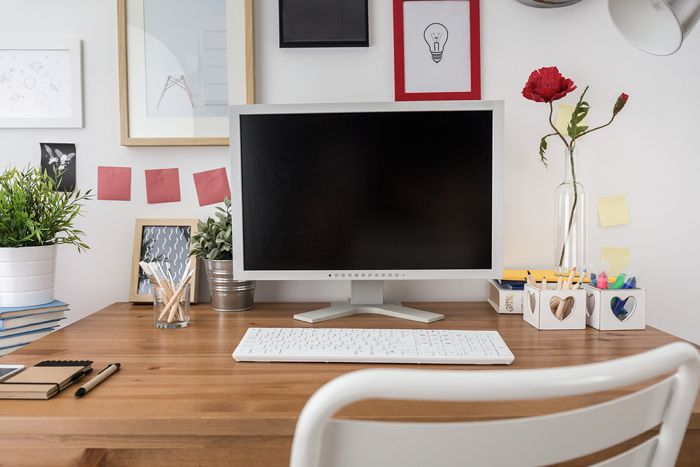
Essential. I love the office I moved into over nine years ago. It was always my favorite room in this old farm house, but it was my husband’s office and my office was upstairs. Now this spacious room is all mine–some benefits can be found to any catastrophe. It has a huge writing table large enough for plenty of free space plus printer, docking station, and large screen, a free-standing propane stove for the coldest days (last week, for example), windows on 3 walls with shades when needed, a view of the bird feeders and the sunset, spacious built-in book shelves and a working table with no computer. Biggest problem is my clutter and my resistance to filing the old bills and old papers, but I’m tackling that a little every day. Grateful for a writing space that nurtures me.
That sounds absolutely divine, Elaine! How lovely. :O)
We too have a bedroom that’s been converted to an office. I can work there in spurts, but not for any length of time. It’s too isolated. Love your new desk.
Totally get that. You feel sort of locked away at times, eh? Thanks! Not expensive, either. Definitely some good deals out there. :O)
I began decluttering and rearranging my desk/writing space during the holiday break. It lead to increasing the length of my desk space by adding 3 file low cabinets to one end. Once I moved my printer there, and my monitor to the “L” I added to the other end, the whole window was in view and I felt like I was in an ocean instead of a pond. It’s just what I needed. next, I’ll tackle the art table and find space to hide what I can. Prioritizing, organizing and decluttering are the stand outs for me. Great article!
That sounds awesome, Kimberly! Love that—an ocean instead of a pond. I can almost feel the space… :O)
When I moved my computer table against a wall near a window, my whole attitude toward sitting down to work changed. This time of year, I can see the sunrise (and the colors have been beautiful), plus the front yard tree where the woodpeckers and a pygmy nuthatch hang out a lot. I also put a 4 ft table in front of the window so when I stand to do paper sorting and filing or other stand-up work, I can look outside from time to time.
Plants really are helpful in lots of ways, and I used to have dozens. When Katie Cat joined our household, however, the plants had to go. If she wasn’t trying to eat them, she was digging in the dirt and knocking over the pots.
Sounds like we had similar experiences there, Pat. The windows sure do make a big difference! Aww, darn it! Ha ha. Cats do like to play in that dirt, for sure. Thankfully mine doesn’t bother the plants unless we’re at my Mom’s place–she thinks “grandma’s” pots are fair game for some reason!